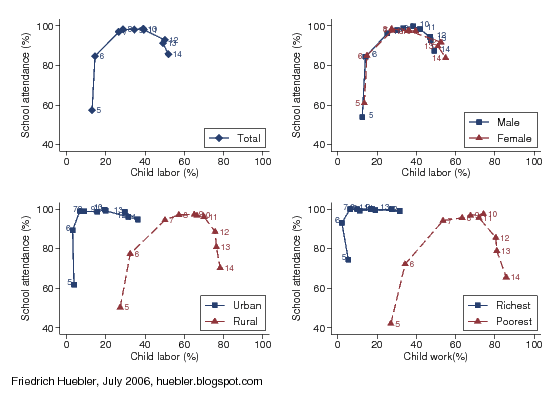For the purpose of this analysis, child labor is defined as any economic activity during the week of the survey, or more than two hours of household chores per day. The data for Bolivia were collected in a Multiple Indicator Cluster Survey (MICS) in 2000. The previous post presented the data on child labor and schooling disaggregated by age group, sex, area of residence, and household wealth. Today's article will take a closer look at the pattern of work and school attendance by age.
The graph belows present the share of children aged 5 to 14 years who attend school or are engaged in child labor. School attendance is defined as attending any level of education at the time of the MICS survey. Each point represents children of a single age, from 5 years, 6 years, and so on, to 14 years of age. Child labor rates are plotted against the horizontal axis, school attendance rates against the vertical axis.
Child labor and school attendance by age, children 5-14 years, Bolivia

Data source: Bolivia 2000 MICS.
The upper left quadrant shows the values for all children combined. The inverted U shape indicates that children work steadily more as they grow older, while school attendance rates reach a peak near 100 percent for children between 7 and 11 years of age and then decrease again. The upper right quadrant, with data disaggregated by gender, makes clear that there is no difference between boys and girls in Bolivia, as far as work and school are concerned.
There are, however, big differences between children from urban and rural areas, as the lower left quadrant shows. Among urban children, school attendance rates rise rapidly with age and at 7 years, 99 percent of all children are in school. Few children drop out as they grow older and among 14-year-olds, the school attendance rate is still 95 percent. In rural areas, school attendance rates for children between 7 and 11 years of age are also above 90 percent.
Compared to urban children, rural children are much more likely to be engaged in child labor. The highest child labor rate in urban areas is observed for children 14 years old (36 percent). In contrast, one third of all 6-year-olds (32 percent) and half of all 7-year-olds (50 percent) do child labor. Child labor rates continue to increase with age and at 14 years, 78 percent of all rural children work, compared to 70 percent in this age group who attend school.
The last graph, in the lower right quadrant, compares children from the richest and poorest 20 percent of all households. The overall pattern is very similar to that for urban and rural children. Children from wealthy households are much more likely to attend school and less likely to work than children from poor households. In the richest household quintile, school attendance rates are between 99 and 100 percent for all children aged 7 to 14 years, while child labor rates do not exceed 32 percent. In the poorest household quintile, the child labor rate reaches 86 percent among 14-year-old children. 66 percent of 14-year-olds from the poorest household are in school.
A comparison of the individual graphs makes clear that the overall pattern of child labor and school attendance in Nepal is strongly influenced by children from poor, rural households. Many of these children work and do not complete their education.
Related articles
- Child labor and school attendance in Bolivia
- Child labor and school attendance
- Child labor: economic activity and household chores
- Primary school attendance in Bolivia
- Secondary school attendance in Bolivia
- Education data from household surveys
- UNICEF priority countries for girls' education
- Household wealth and years of education
Permanent URL: http://huebler.blogspot.com/2006/07/child-labor-and-school-attendance-in.html